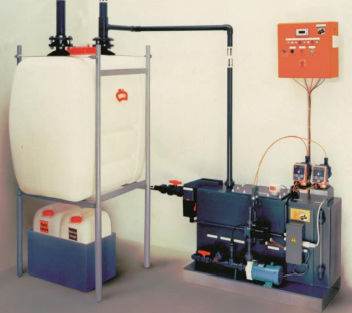
Neutralization water treatment system TC 105
Add to favorites
Compare this product
fo_shop_gate_exact_title
Characteristics
- Technology
- neutralization
Description
The chemically contaminated wastewater is collected in the wastewater storage tank and fed into the neutralisation system through a pump and solenoid valve.
Level sensors control and monitor the filling level ("min", "max", "alarm") in the waste water storage tank and in the neutralisation tank and also prevent the pump from running dry.
When the maximum filling level is reached in the neutralisation tank, the inlet valve is closed. At the same time, the mixing/channel pump of the neutralisation system is switched on. Now a circulation in the neutralization tank starts, to ascertain an accurate pH measured value (adjustable).
After the predetermined time and reaching the set pH value, pumping is carried out into the sewage.
A pH electrode in the intake pipe of the special pump continuously determines the pH value. This is visibly displayed digitally on the switchboard.
If the neutral pH value is not reached after the circulation time, lye or acid is added by electromagnetic diaphragm dosing pumps from 25 - 140 litre containers. To keep the consumption of lye and acid as low as possible, the lye and acid line leads directly into the mixing circuit. By permanently measuring the pH value
and adding lye or acid at intervals, the feared overturning is avoided.
A pH combination electrode in the suction line of the mixing channel pump constantly determines the pH value. This is visibly displayed digitally on the control cabinet. Once the neutral pH value is reached, a variably adjustable remixing time takes place. Afterwards, the neutralised waste water is pumped into the discharge pipe.
The pump switches off after reaching the minimum filling level
Catalogs
TC 105
5 Pages
Related Searches
- Tritec cabinet refrigerator
- Tritec 1-door refrigerator
- Tritec automatic defrost refrigerator
- Tritec refrigerator with glass door
- Tritec pharmacy refrigerator
- Electric refrigerator
- Tritec stainless steel refrigerator
- Tritec 2-door refrigerator
- Tritec hospital refrigerator
- Tritec air-cooled refrigerator
- 3-door refrigerator
- Healthcare facility water treatment system
- Tritec refrigerator with independent circuits
*Prices are pre-tax. They exclude delivery charges and customs duties and do not include additional charges for installation or activation options. Prices are indicative only and may vary by country, with changes to the cost of raw materials and exchange rates.









